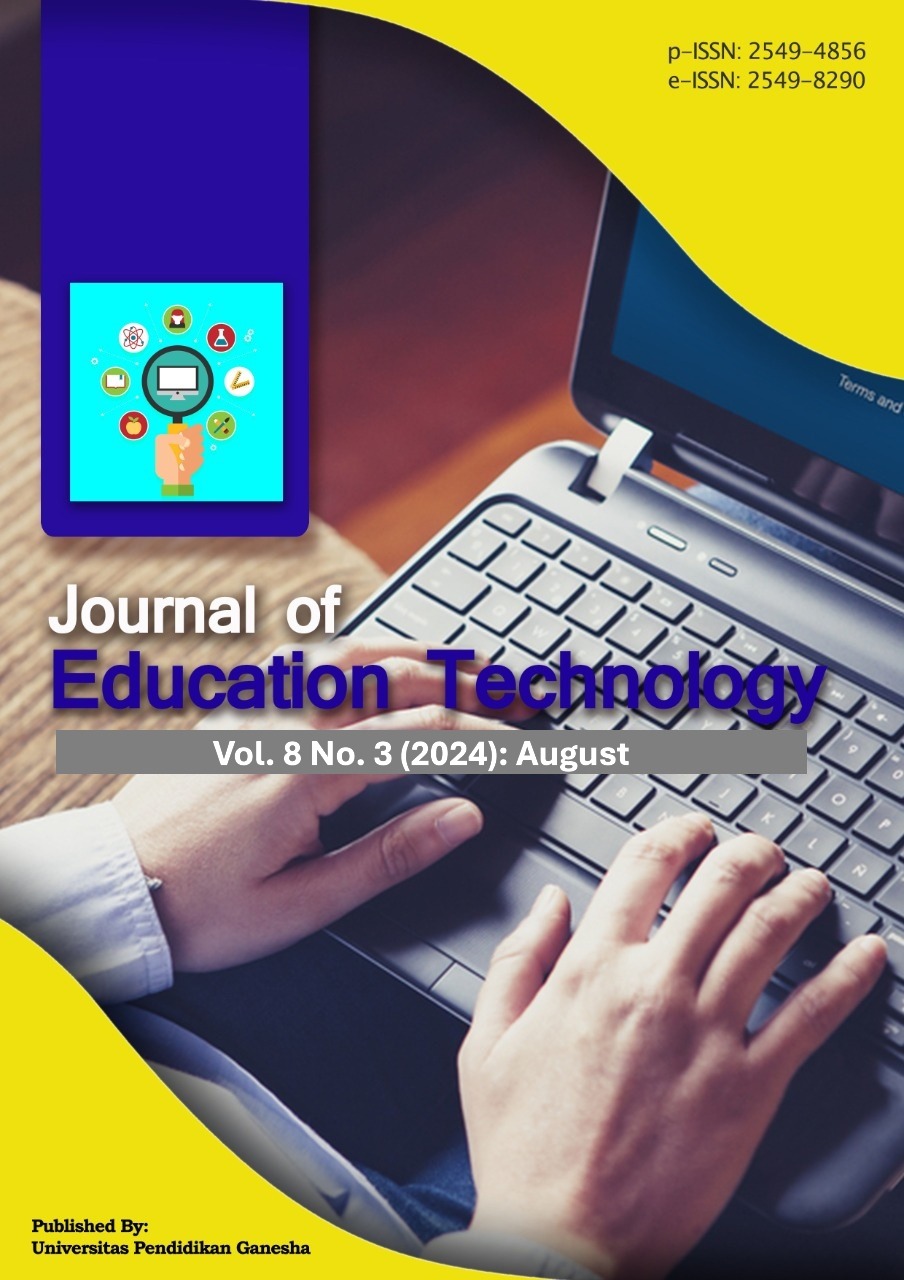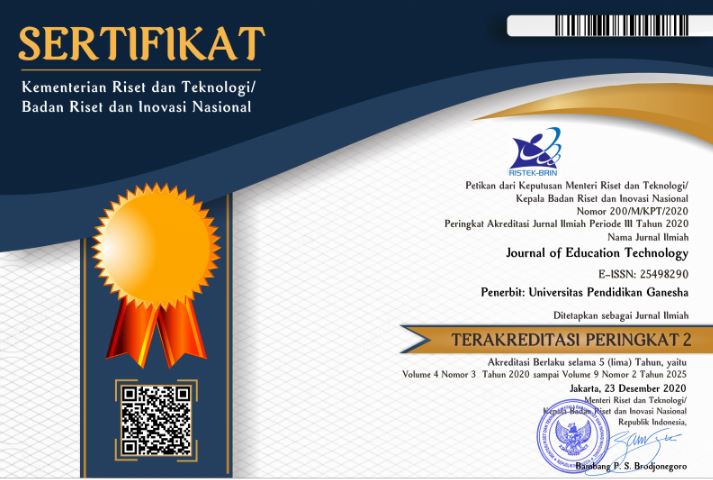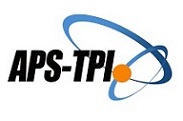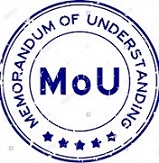Improving the Use of Learning Media through the Development of E-Storybooks for Fifth-Grade Students
DOI:
https://doi.org/10.23887/jet.v8i3.81100Keywords:
E-Storybooks, Merdeka Curriculum, Supplementary Material, Young LearnerAbstract
The availability of supplementary materials in learning needs to be improved. Due to the change in curriculum, it was difficult for teachers to prepared materials so that they only rely on textbooks. Therefore, this research was conducted on the development of e-storybooks integrated with the Merdeka Curriculum for fifth-grade students. This research aimed to produced e-storybooks that were interactive, innovative, interested and integrated with the Curriculum. Design and Development (D&D) model used in this research which included four stages namely Analysis, Design, Development, and Evaluation, which combined with qualitative and quantitative methods. First, learning problems, teacher and students’ interviews, and document were analyzed. Second, it continued with the development of blueprints related to the developed topics and then the creation of product layouts. The third stage, the e-storybooks were developed by Canva and Book Creator, then revised according to the experts’ feedback and judged by experts. The last stage, conducted product trial, interviews, and product quality judgment which involved teacher and students. This research resulted e-storybooks that were maximally beneficial, being useful as good alternative learning media for language learning, vocabulary development and interested learning experienced for students. Through the results of this study, e-storybooks can be a new alternative as supplementary materials to support learning so that teachers should maximize the use of supplementary materials that are integrated with the curriculum and technology.
References
Adnyana, I. K. S., Dewa Ayu Made Manu Okta Priantini, & Ni Made Suarningsih. (2023). Tri Kaya Parisudha’s Image-Oriented Story Media to Increase The Interest in Reading of Three Grade Elementary School Students. International Journal of Elementary Education, 7(1), 27–35. https://doi.org/10.23887/ijee.v7i1.58209.
Adnyani, L. D. S., Suprianti, G. A. ., Marsakawati, N. P. E., & Narotama, P. D. A. (2021). Powtoon as the Implementation of Edutainment for Young Learners. Proceedings of the 2nd International Conference on Technology and Educational Science (ICTES 2020), 540(Ictes 2020), 205–209. https://doi.org/10.2991/assehr.k.210407.239.
Afzal, N. (2019). A Study on Vocabulary-Learning Problems Encountered by BA English Majors at the University Level of Education. Arab World English Journal, 10(3), 81–98. https://doi.org/10.24093/awej/vol10no3.6.
Ainon, R., & Rosmaizura, M. Z. (2018). The impact of facilities on student choice. Sci.Int.(Lahore), 30(2), 299–311.
https://www.researchgate.net/profile/rosmaizura-mohd-zain/publication/337590619.
Andriana, E., Syachruroji, A., Alamsyah, T. P., & Sumirat, F. (2017). Natural science Big Book with Baduy local wisdom base media development for elementary school. Jurnal Pendidikan IPA Indonesia, 6(1), 76–80. https://doi.org/10.15294/jpii.v6i1.8674.
Artila Dewi, N. P., Sintadewi, M. D., & Suryantini, M. D. (2023). Urgency of Teaching English to Young Learners in Kurikulum Merdeka Belajar. Riwayat: Educational Journal of History and Humanities, 4(2), 188–196. https://doi.org/10.24815/jr.v6i1.29427.
Aslamiah, S. (2022). Characteristic English Learning Style for Young Learner in New Normal Era. Intensive Journal, 5(2), 104. https://doi.org/10.31602/intensive.v5i2.7334.
Asmahasanah, S., Chairunnissa, I. C., & Hakim, N. (2023). Navigating Merdeka curriculum in first grade: teacher challenges and strategies. Journal of Integrated Elementary Education, 3(2), 137–149. https://journal.walisongo.ac.id/index.php/jieed/article/view/17592.
Ayuningtias, S., & Kareviati, E. (2021). The Preparation Of Instructional Media In Teaching English To Young Learners At Sdn Baros Mandiri 3 Cimahi. PROJECT (Professional Journal of English Education), 4(3), 414–419. https://pdfs.semanticscholar.org/2cf8/584908daac4f0b3c382bf3bdeb5359d5fedb.pdf.
Britiviliani, N., & Rahmawati, E. (2018). Use of Picture Books to Expose Young Learners Writing Activities. Loquen: English Studies Journal, 11(2), 60.
Charitidou, E., & Anastasiadou, A. (2011). Investigation Their Effectiveness to Foster Young EFL Learneers Multiple Intelligences. E. Charitidou, A. Anastasiadou, 24(2022), 195–212. http://ejournals.lib.auth.gr/thal/article/view/9156.
Colwell, C. (2013). Children’s storybooks in the elementary music classroom : A description of their use by orff-schulwerk teachers. Music Therapy & Special Music Education, 5(2), 175–187. https://kuscholarworks.ku.edu/handle/1808/14153.
Cordes, A.-K., Egert, F., & Hartig, F. (2023). Fostering Child Language with Short-Term Digital Storybook Interventions. Zeitschrift Für Entwicklungspsychologie Und Pädagogische Psychologie, 0. https://doi.org/10.1026/0049-8637/a000264.
Dhirapriyani, K., Suprianti, G. A. P., & Budiarta, L. G. R. (2024). Empowering first- grade students ’ learning : enhancing education through English e-Storybooks aligned with the emancipated curriculum. The Art of Teacihing English as a Foreign Language, 5(1), 32–48. https://doi.org/10.36663/tatefl.v5i1.665.
Ferdaus, S. A., & Novita, D. (2023). The Implementation of The Merdeka Curriculum in English Subject at A Vocational High School in Indonesia. Briliant: Jurnal Riset Dan Konseptual, 8(2), 297. https://doi.org/10.28926/briliant.v8i2.1201.
Fibriasari, H., Baharuddin, Gultom, S., Gultom, S., Restuati, M., Ritonga, W. P., Dalle, J., Putra, A. P., Biyatmoko, D., Mutalib, A. A., Azizah, C. N., & Andayani, W. (2022). Developing Digital Storybook to Improve Children’s Language Learning. Proceedings of the 6th Annual International Seminar on Transformative Education and Educational Leadership (AISTEEL 2021), 591(Aisteel), 967–977. https://doi.org/10.2991/assehr.k.211110.214.
Handayani, E., Puspita, N., Syamsiah, N., Islam, U., Raden, N., & Lampung, I. (2023). The Influence Of Using Book Creator Application Toward Students ’ Performance In Writing Procedural Text. Jurnal Ilmiah Pendidikan Bahasa, Sastra, Dan Matematika, 3783(December), 1–17. http://journal.fkip-unilaki.ac.id/index.php/dia/article/view/43.
Harpiyani, R., Hendriana, B., & Vinayastri, A. (2022). Development of “Love the Motherland” Digital Storybook for Early Childhood. Jurnal Teknologi Informasi Dan Pendidikan, 15(2), 38–50. https://doi.org/10.24036/jtip.v15i2.605.
Hendratno, H., Yermiandhoko, Y., & Yasin, F. N. (2022). Development of interactive story book for ecoliteration learning to stimulate reading interest in early grade students elementary school. IJORER : International Journal of Recent Educational Research, 3(1), 11–31. https://doi.org/10.46245/ijorer.v3i1.179.
Johan, R., & Harlan, J. (2014). Education Nowadays. International Journal of Educational, 4(5), 6. https://journal.uny.ac.id/index.php/hsjpi/article/view/31686.
Klop, D., Marais, L., Msindwana, A., & de Wet, F. (2018). Learning new words from an interactive electronic storybook intervention. South African Journal of Communication Disorders, 65(1), 1–8. https://doi.org/10.4102/sajcd.v65i1.601.
Kurt, S. (2017). ADDIE Model: Instructional Design. Frameworks & Theories. https://doi.org/10.1017/CBO9781107415324.004.
Marhamah, F., Muslem, A., & Marhaban, S. (2022). An Investigation On Using Teaching Media In Teaching Speaking Skill. English Education Journal (EEJ), 13(1), 32–45. https://doi.org/10.24815/eej.v13i1.23147.
Mart, C. T. (2012). Encouraging young learners to learn English through stories. English Language Teaching, 5(5), 101–106. https://doi.org/10.5539/elt.v5n5p101.
Mayer, R. E. (2017). Using Multimedia for E-Learning. In Journal of Computer Assisted Learning. https://doi.org/10.1111/jcal.12197.
Mubar, M. K. N. A. (2015). Developing English Learning Materials For Young Learners Based On Needs Analysis At Mtsn Model Makassar. ETERNAL (English, Teaching, Learning, and Research Journal), I(02), 257–269. https://doi.org/10.24252/Eternal.V12.2015.A8.
Mulyoto, G. P; Tsamrotu, I. M; Puspitasari, D. A. (2023). Developing Electronic-Based Picture Storybooks to Enhance Student Learning Motivation. Jurnal Pendidikan Dan Pembelajaran Dasar, 2(4), 1607–1614. http://repository.uin-malang.ac.id/15099/7/15099.pdf
Ogay, M. (2020). Use of Multimedia in Teaching English To Young Learners. European Journal of Research and Reflection in Educational Sciences, 8(4), 1–10. https://www.idpublications.org/wp-content/uploads/2020/04/full-paper-use-of-multimedia-in-teaching-english-to-young-learners.pdf.
Putri, S. R., Usman, H., & Sakmal, J. (2022). Development Learning Media E-Book Based on TPACK on Natural Science Education in Elementary School. Indonesia Journal of Learning Education and Counseling, 5(1), 30–34. https://doi.org/10.31960/ijolec.V5i1.1688.
Rahayu, Y. S., Mujiyanto, J., Suwandi, S., & Fitriati, S. W. (2023). The Impact of Electronic Storybook and Print Picture Book on the Reading Comprehension of Undergraduates with Varying Levels of Critical Thinking. Migration Letters, 20, 224–237.
https://jurnal.stkipahsingaraja.ac.id/index.php/tatefl/article/view/665.
Richter, A., & Courage, M. L. (2017). Comparing electronic and paper storybooks for preschoolers: Attention, engagement, and recall. Journal of Applied Developmental Psychology, 48, 92–102. https://doi.org/10.1016/j.appdev.2017.01.002.
Riyanto, Amin, M., Suwono, H., & Lestari, U. (2020). The new face of digital books in genetic learning: A preliminary development study for students’ critical thinking. International Journal of Emerging Technologies in Learning, 15(10), 175–190. https://doi.org/10.3991/ijet.v15i10.14321.
Septiana, E., Yufrizal, H., & Sukirlan, M. (2017). Developing Supplementary Reading Materials For Efl Young Learners Of The Fifth Grade. 4(1), 9–15. https://core.ac.uk/download/pdf/291529456.pdf.
Smeets, D. J. H., & Bus, A. G. (2015). The interactive animated e-book as a word learning device for kindergartners. Applied Psycholinguistics, 36(4), 899–920. https://doi.org/10.1017/S0142716413000556.
Case Study Of An Elementary School Teacher In Bandung ). Journal of English and Education, 3(2), 90–100. https://core.ac.uk/download/pdf/295400829.pdf.
Suprianti, G. A. ., Budiarta, L. G. ., & Indrayani, L. (2024). Powtoon: Does It Promote Primary Students’ Autonomous Learning? Journal of English Education and Teaching (JEET), 8(1), 106–128. https://doi.org/10.33369/jeet.8.2.355-372.
Suprianti, G. A. ., Mahayanti, N. W. ., & Suarjaya, P. A. A. . (2020). Learning English in third grade through Powtoon. Journal of Education Technology, 4, 120–126. https://doi.org/10.23887/jet.v4i2.24087.
Suprianti, G. A. P. (2020). Powtoon animation video: a learning media for the sixth graders. VELES Voices of English Language Education Society, 4(2), 152–162. https://doi.org/10.29408/veles.v4i2.2536.
Tamrin, A. F., & Magfirah, S. (2019). Nature Theme Pictured Book Used in Teaching English for Elementary Students. Eralingua: Jurnal Pendidikan Bahasa Asing Dan Sastra, 3(1), 16–25. https://doi.org/10.26858/eralingua.v3i1.8759.
Tanak, A. (2020). Developing Preservice Science Teachers’ Teaching Practices with an Emphasis on Higher Order Thinking. Science Education International. https://doi.org/10.33828/sei.v31.i3.2.
Wahyuni, L. G. E., & Pratiwi, N. P. A. (2021). Enhancing EFL students ’ speaking competency through animated learning video. 4th International Conference on Innovative Research Across Disciplines, 613(Icirad), 181–187. https://doi.org/10.2991/assehr.k.211222.029.
Williams, M. (2002). Teaching Languages to Young Learners. L. Cameron. ELT Journal, 56(2), 201–203. https://doi.org/10.1093/elt/56.2.201.
Yunita Adriyanti, K. (2021). Implementation of Character Education in Teaching English For Young Learners. The Art of Teaching English as a Foreign Language, 2(1), 17–23. https://doi.org/10.36663/tatefl.v1i2.98.
Zakiyah, M., & Fitrawati, F. (2020). An Analysis of Lecturers’ Perception toward the Interactive E-book used in Advanced Grammar at English Department of Universitas Negeri Padang. Journal of English Language Teaching, 9(1), 173. https://doi.org/10.24036/jelt.v9i1.107895.
Zidan, M. R. (2023). A Literature Study On The Implementation Of Merdeka Curriculum. Jurnal Riset Rumpun Ilmu Bahasa (JURRIBAH), 2(2), 153–167. https://doi.org/10.55606/jurribah.v2i2.1576.
Downloads
Published
How to Cite
Issue
Section
License
Copyright (c) 2024 Ni Putu Riza Clarita Pitaloka, G.A.P Suprianti, Luh Gede Eka Wahyuni

This work is licensed under a Creative Commons Attribution-ShareAlike 4.0 International License.
Authors who publish with the Journal of Education Technology agree to the following terms:
- Authors retain copyright and grant the journal the right of first publication with the work simultaneously licensed under a Creative Commons Attribution License (CC BY-SA 4.0) that allows others to share the work with an acknowledgment of the work's authorship and initial publication in this journal.
- Authors are able to enter into separate, additional contractual arrangements for the non-exclusive distribution of the journal's published version of the work (e.g., post it to an institutional repository or publish it in a book), with an acknowledgment of its initial publication in this journal.
- Authors are permitted and encouraged to post their work online (e.g., in institutional repositories or on their website) prior to and during the submission process, as it can lead to productive exchanges, as well as earlier and greater citation of published work. (See The Effect of Open Access)
















